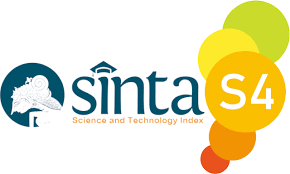Utilization of Nanocellulose Fiber from Tapioca Industrial Solid Waste as a Bioplastic Filling Material
Abstract
This study aims to examine the properties of nanocellulose fibers produced from cassava through the acid hydrolysis process, as well as their potential use as a filler for bioplastics based on cassava starch (tapioca). The treatment of this research was acid hydrolysis process time consisting of 15 and 30 minutes and the use of nanocellulose fiber as a filler for bioplastics as much as 0%, 1%, 2%, and 3% w/w starch. The results of this study indicate that the diameter of the nanocellulose fibers produced is about 18-40 nm, good dispersion stability, the crystallinity index of the nanocellulose fibers produced by acid hydrolysis for 15 and 30 minutes are 39.7% and 31.2%, respectively. The addition of nanocellulose fibers can increase the tensile strength, but decrease its elongation ability.
References
Benini, K. C. C. C., Pereira, P. H. F., Cioffi, M. O. H., & Voorwald, H. J. C. (2017). Effect of acid hydrolysis conditions on the degradation properties of cellulose from Imperata brasiliensis fibers. Procedia Engineering, 200, 244–251.
Fauzi, A. M., Rahmawakhida, A, & Hidetoshi, Y. (2010) . Kajian produksi bersih di industri kecil tapioka: Kasus Kelurahan Ciluar, Kecamatan Bogor Utara. Jurnal Teknologi Industri Pertanian, 18(2), 60-65.
Ilyas, R. A., Sapuan, S. M., Atikah, M. S. N, Asyraf, M. R. M., Rafiqah, S. A., Aisyah, H. A., Nurazzi, N. M., & Norrrahim, M. N. F. (2021). Effect of hydrolysis time on the morphological, physical, chemical, and thermal behavior of sugar palm nanocrystalline cellulose (Arenga pinnata (Wurmb.) Merr). Textile Research Journal, 91(1–2), 152–167.
Johar, N., Ahmad, I., & Dufresne, A. (2012). Extraction, preparation and characterization of cellulose fibers and nanocrystals from rice husk. Industrial Crops and Products, 37, 93-99.
Juliantoni Y., Hajrin, W., & Subaidah, W. A. (2020). Nanoparticle formula optimization of juwet seeds extract (Syzygium cumini) using Simplex Lattice Design Method. Jurnal Biologi Tropis, 20(3), 416-422.
Khalid, M. Y., Al Rashid, A., Arif, Z. U., Ahmed, W., & Arshad, H. (2021). Recent advances in nanocellulose-based different biomaterials: types, properties, and emerging applications. Journal of Materials Research and Technology, 14, 2601-2623.
Kusmono, R. F., Listyanda, M. W., Wildan, & Ilman, M. N. (2020). Preparation and characterization of cellulose nanocrystal extracted from ramie fibers by sulfuric acid hydrolysis. Heliyon, 6 e05486.
Lee, K. Y., Aitomäki, Y., Berglund, L. A., Oksman, K., & Bismarck, A. (2014). On the use of nanocellulose as reinforcement in polymer matrix composites. Composites Science and Technology, 105, 15–27.
Li, M., Han, G., Song, Y., Jiang, W., & Zhang, Y. (2016). Structure, composition, and thermal properties of cellulose fibers from Pueraria lobata treated with a combination of steam explosion and laccase mediator system. BioResources, 11(3), 6854-6866.
Nair, M. P. D., Padmaja, G., Sajeev, M. S., & Sheriff, J. T. (2012). Bioconversion of cellulo-starch waste from cassava starch industries for ethanol production: Pretreatment techniques and improved enzyme systems. Industrial Biotechnology, 8(5), 300-308.
Omran, A. A. B., Mohammed, A. A. B. A., Sapuan, S. M., Ilyas, R. A., Asyraf, M. R. M., Koloor, S. S. R, & Petru, M. (2021). Micro- and nanocellulose in polymer composite materials: a review. Polymers, 13, 231. https://doi.org/10.3390/ polym13020231.
Sheltami, R. M., Abdullah, I., Ahmad, I., Dufresne, A., & Kargarzadeh, H. (2012). Extraction of cellulose nanocrystals from mengkuang leaves (Pandanustectorius). Carbohydrate Polymers, 88, 772-779.
Silva, H. D., Cerqueira, M. A., & Vicente, A. A. (2012). Nanoemulsions for food applications: developmentand characterization. Food and Bioprocess Technology, 5, 854–867.
Teixeira, E. M., Pasquini, D., Curvelo, A. A. S., Corradini, E., Belgacem, M. N., & Dufresne, A. (2009). Cassava bagasse cellulose nanofibrils reinforced thermoplastic cassava starch. Carbohydrate Polymers, 78, 422-431.
Tonoli, G. H. D, Teixeira, E. M., Corrêa, A. C., Marconcini, J. M., & Caixeta, L. A. (2012). Cellulose micro/nanofibres from Eucalyptus kraft pulp: preparation and properties. Carbohydrate Polymers, 89, 80-88.
Valerga, A. P., Fernandez-Vidal, S. R., Girot, F., & Gamez, A. J. (2020). On the relationship between mechanical properties and crystallisation of chemically post-processed additive manufactured polylactic acid pieces. Polymers, 12, 941. doi:10.3390/polym12040941.
Wu, Y., Huang, A., Fan, S., Liu, Y., & Liu, X. (2020). Crystal structure and mechanical properties of uniaxially stretched PA612/SiO2 films. Polymers, 12, 7. doi:10.3390/polym12030711.
Wulandari, W. T., Rochliadi, A., & Arcana, I. M. (2016). Nanocellulose prepared by acid hydrolysis of isolated cellulose from sugarcane bagasse. IOP Conf. Series: Materials Science and Engineering, 107 012045. doi:10.1088/1757-899X/107/1/012045
Yuwono, M., Fauziah, B., Isnaeni, & Nisak, A. (2020). Tensile strength and elongation analysis on nano cellulose film isolated from sugarcane bagasse. IOP Conf. Series: Earth and Environmental Science, 456 012088. doi:10.1088/1755-1315/456/1/012088.











